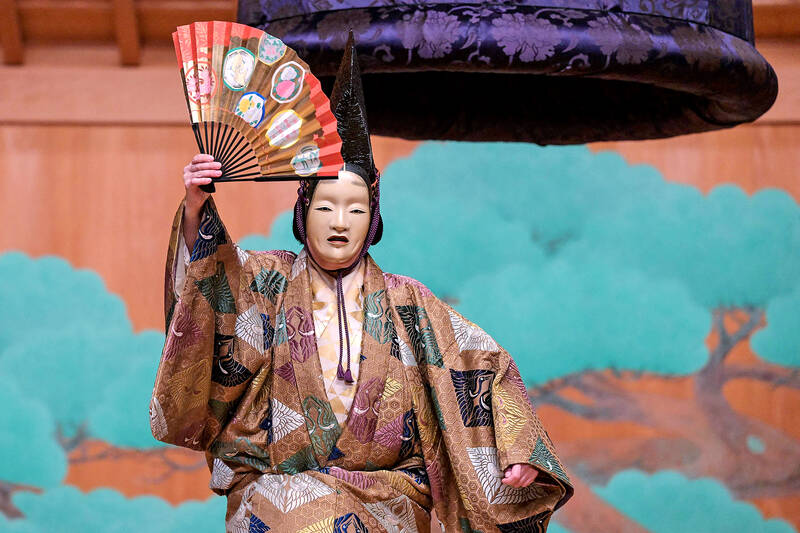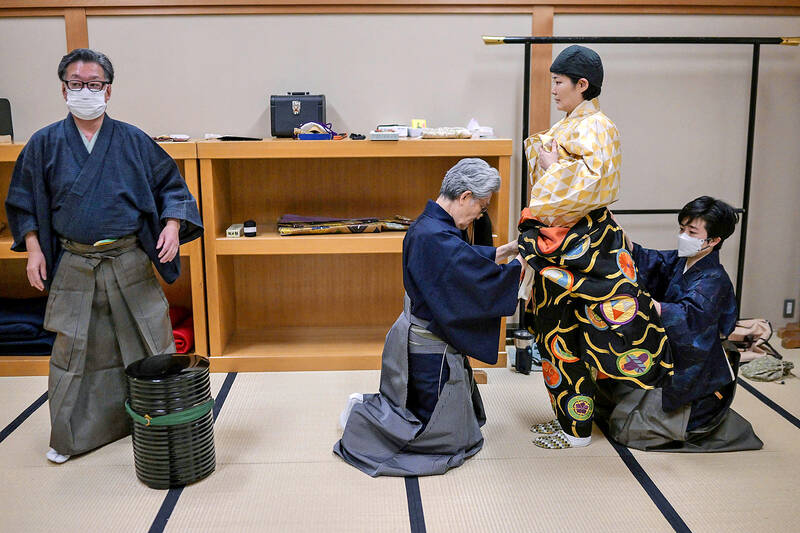Kimono-clad Mayuko Kashiwazaki delivers her lines in guttural tones and transforms into an evil snake in the lead role of a Japanese Noh play where, unusually, most of the cast are women.
Noh, with its elaborate layered costumes and hand-crafted masks, is one of the most ancient surviving forms of theatre, with origins dating back to the eighth century.
Unlike kabuki, another type of classical Japanese theater, or sumo wrestling — both steadfastly male — Noh has been open to performers of both genders for over a century.

Photo: AFP
But women are still a rarity in the traditional Noh world, where fathers often pass the vocation to their sons.
Women represent just 15 percent of the 1,039 actors and musicians registered with the professional Nohgaku Performers’ Association.
And their opportunities to appear on stage are “relatively limited,” 43-year-old Kashiwazaki said.

Photo: AFP
“One reason is that Noh audiences are generally older, and often see Noh as a masculine art form,” she said.
But now it’s time “for women to reflect on their future in Noh, and to play a role in building that future.”
Kashiwazaki acted the principal part in Dojoji, a famous drama about the revenge of a betrayed woman, at Tokyo’s National Noh Theater last weekend.
Twirling a fan, and wearing a heavy kimono embroidered with a crane motif, the masked actor belted out her lines in an archaic, warbling style as the story slowly unfolded.
After hiding under a prop representing the bell of a Buddhist temple, she emerged transformed as a demonic serpent character with wild, fiery tufts of red hair.
‘BEAUTY AND POWER’
Kashiwazaki, encouraged by her Noh mentor, tried to find as many women as possible to participate in the production.
“Dojoji is an extremely important piece for Noh actors,” Kashiwazaki said, and “you have to be very lucky to get a chance to perform it, even once in your life.”
“Because I was lucky enough to have this opportunity, I thought it would be great to stage it with other female Noh actors.”
Yoko Oyama, who played a handheld drum in the show, said it was unusual to see “so many women in the chorus and among the musicians on stage.”
“It’s not only the fact that they are women, but also that most of them are young for Noh performers, which makes the show even more special,” she said.
However, for some parts, including the supporting actor or “waki” in Noh — often a monk or priest character — there were no women to fill the role, so it was played by a man.
“There are no women performing waki... it has always been that way,” Kashiwazaki’s mentor, 72-year-old Yasuaki Komparu, told AFP.
While Komparu is the scion of one of five prominent Noh families that have bred generations of actors, Kashiwazaki first discovered Noh as a student.
She was charmed by its lyrical dramas and the heavily stylized acting in a minimal setting. A painting of a pine tree behind the stage is usually the only decoration.
“I was fascinated by how cool this Japanese art form looked, and thought I could only truly understand it by taking part myself,” she said.
‘VICIOUS CYCLE’
Kashiwazaki’s first mentor tried to dissuade her from becoming a Noh actor, having experienced herself the difficulties women face in the ancient art.
Now recognized by UNESCO as “intangible cultural heritage,” Noh developed towards its current form in Japan’s Muromachi era from 1336 to 1573, a period when the performers included women among their ranks.
In the Edo era from 1603 to 1868, patronage from shoguns helped Noh’s popularity grow.
But women were banned from the stage under government morality rules that repressed individual liberties.
Only at the end of the 19th century were women once again allowed to act in Noh, but they had to wait until 1948 to be recognized as professionals.
“There are extraordinary Noh actors, men and women, but the public tends to seek out a particular type of Noh, with a fixed idea of what it should be,” Kashiwazaki said.
That lack of opportunities creates a “vicious cycle” because actors can’t build up the experience to progress their careers, she said.
After Saturday’s show, audience member Kazuaki Ieda, 40, said he was “very interested and excited” by the performance.
“I think this may be the future of Noh in Japan,” Ieda said.

The canonical shot of an East Asian city is a night skyline studded with towering apartment and office buildings, bright with neon and plastic signage, a landscape of energy and modernity. Another classic image is the same city seen from above, in which identical apartment towers march across the city, spilling out over nearby geography, like stylized soldiers colonizing new territory in a board game. Densely populated dynamic conurbations of money, technological innovation and convenience, it is hard to see the cities of East Asia as what they truly are: necropolises. Why is this? The East Asian development model, with

June 16 to June 22 The following flyer appeared on the streets of Hsinchu on June 12, 1895: “Taipei has already fallen to the Japanese barbarians, who have brought great misery to our land and people. We heard that the Japanese occupiers will tax our gardens, our houses, our bodies, and even our chickens, dogs, cows and pigs. They wear their hair wild, carve their teeth, tattoo their foreheads, wear strange clothes and speak a strange language. How can we be ruled by such people?” Posted by civilian militia leader Wu Tang-hsing (吳湯興), it was a call to arms to retake

This is a deeply unsettling period in Taiwan. Uncertainties are everywhere while everyone waits for a small army of other shoes to drop on nearly every front. During challenging times, interesting political changes can happen, yet all three major political parties are beset with scandals, strife and self-inflicted wounds. As the ruling party, the Democratic Progressive Party (DPP) is held accountable for not only the challenges to the party, but also the nation. Taiwan is geopolitically and economically under threat. Domestically, the administration is under siege by the opposition-controlled legislature and growing discontent with what opponents characterize as arrogant, autocratic

Desperate dads meet in car parks to exchange packets; exhausted parents slip it into their kids’ drinks; families wait months for prescriptions buy it “off label.” But is it worth the risk? “The first time I gave him a gummy, I thought, ‘Oh my God, have I killed him?’ He just passed out in front of the TV. That never happens.” Jen remembers giving her son, David, six, melatonin to help him sleep. She got them from a friend, a pediatrician who gave them to her own child. “It was sort of hilarious. She had half a tub of gummies,